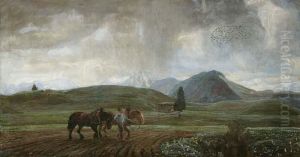Erich Kuithan Paintings
Erich Kuithan was a German landscape painter born on December 1, 1865, in Quedlinburg, a town in Saxony-Anhalt, Germany. He is associated with the late 19th-century German plein air painting movement, which emphasized painting outdoors to capture the nuances of natural light and atmosphere.
Kuithan studied at the Royal Academy of Arts in Berlin under renowned professors such as Eugen Bracht and Paul Friedrich Meyerheim. After his formal education, he embarked on numerous study trips throughout Europe, which significantly influenced his artistic development. His travels took him to Italy, the Netherlands, and within various regions of Germany, where he drew inspiration from the diverse landscapes he encountered.
In 1892, Kuithan settled in Weimar and became part of the Weimar School of Painting, a group of artists known for their naturalistic and often plein air approach to landscape painting. This school was seen as a progressive force in German art, promoting a more direct engagement with nature as a subject for art. Kuithan’s work from this period is characterized by a sensitive representation of the German countryside, with particular attention to the effects of light and seasonal changes on the landscape.
Kuithan was also an influential art educator. In 1905, he was appointed as a professor at the Grand-Ducal Saxon Art School of Weimar, where he taught numerous students and helped shape the next generation of German artists. His commitment to teaching and his active role in the art community of Weimar contributed to his reputation as a respected figure in the German art world of his time.
Despite his relatively short life, Kuithan left behind a significant body of work that captured the beauty and variability of the natural world. His paintings often feature idyllic scenes of rural Germany, reflecting his deep appreciation for the landscape. He remained active as an artist and educator until his untimely death on February 15, 1915, in Weimar. His legacy is preserved in the collections of various German museums and through the works of his students, who continued to propagate the values of plein air painting and naturalism in German art.
